
These Are Just A few Of My Favorites

ALLSPICE Despite the name, this is a spice, not a blend. Its flavor is very assertive, so use it cautiously. Allspice gained popularity in England where it was known as ‘English spice, and has also been called ‘Jamaican pepper’. The name allspice is derived from the blend of spice flavors contained in this one robust evergreen plant.
Whole: Add 2 or 3 to the peppercorns in your pepper-mill for a deeper and rich flavor.
Drop 1 or 2 whole allspice into your hot tea along with a strip of orange peel for a delightful beverage.
Ground: Add a pinch of allspice to your cherry-pie filling for an added ‘punch’.
Stir a little allspice into creamed or buttered spinach.
Use allspice as a seasoning to flavor tomato sauces and chocolatey things .... like cakes, puddings and hot chocolate for an added ‘zip’.

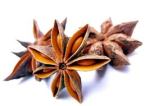 ANISE (aniseed) You will easily recognize Anise’s unmistakable licorice-like taste! It is an annual plant of the carrot family, and has been known since 1500 BC for its aromatic spicy smell. The Egyptians and ancient Romans praised Anise, and it has never lost its reputation as a medicament and as a seasoning.
ANISE (aniseed) You will easily recognize Anise’s unmistakable licorice-like taste! It is an annual plant of the carrot family, and has been known since 1500 BC for its aromatic spicy smell. The Egyptians and ancient Romans praised Anise, and it has never lost its reputation as a medicament and as a seasoning. Seeds: Anise seeds enhances the flavor in broth or tomato-based fish soups.
Stir some anise into puddings for an added subtle flavor.
Add a little to sugar cookies and shortbread when baking for that unique flavor.
Add to cooked or fresh plum and peach desserts to sharpen the taste.
Toss a little anise with coconut, raisins and dried pineapple for a delightful snack.
For a comforting and soothing non-alcoholic nightcap, sir a few anise seeds into hot and sweetened milk.
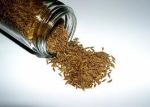
CARAWAY Caraway is a biennial plant of the carrot family, and is one of the oldest spices known to man: remains have been found dating from the Neolithic era when it was used in cooking and particularly in medicine and as a magic plant to chase off evil spirits. The seeds have a distinctive aroma and a pungent taste, most flavorful used ground
Seeds: Sprinkle some caraway seeds into your meat loaf along with a little dill and ground allspice to uplift your meatloaf.
Stir a few seeds into your favorite cheese-bread batter, muffins, and scones.
Delightful sprinkled generously over cabbage dishes, sauerkraut or zucchini before cooking for optimum flavor.
Add a teaspoonful of caraway seeds with the potatoes when boiling them to serve mashed.
Coleslaw is enhanced by the addition of caraway.
Add to your favorite stew and hearty soup recipes.
Sprinkle over liverwurst and other meat sandwiches.
Very complementary when added to your savory dumpling batters and cooked.
Add to roast goose and duck dishes.
Note: Caraway seeds are said to stimulate the function of the stomach, soothe gastric activity and prevent flatulence and intestinal spasms. It is also believe to stimulate the appetite
.
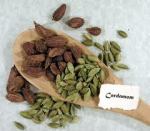 CARDAMOM Even though this is a costly spice, a little goes a long way so do not shy away from its use. It is either loved at first bite, or it becomes a slower-blooming romance for others because the seeds have a strong, camphor-like smell and a pungent taste. Cardamom was used as a seasoning and medicament by the Greeks and Romans, as still today in Western civilization.
CARDAMOM Even though this is a costly spice, a little goes a long way so do not shy away from its use. It is either loved at first bite, or it becomes a slower-blooming romance for others because the seeds have a strong, camphor-like smell and a pungent taste. Cardamom was used as a seasoning and medicament by the Greeks and Romans, as still today in Western civilization.Seeds: (from green or green-bleached-white pods): Nibble after a rich meal.
Bruise 2 or 3 cardamom seeds and add to your coffee grounds while brewing.
Ground: Mix cardamom with sugar and sprinkle on French toast and hot or cold fruit compotes.
Add to your favorite waffle batter.


CAYENNE (ground red pepper) Cayenne is a perennial tropical plant with the fruits from which this pepper is made, being extremely pungent. Cooks often reach for hot, hot cayenne when a savory dish ‘just needs something’.
Cayenne powder will give a delightful lift to tend-to-be-bland egg dishes.
Stir a little into cream cheese spreads and guacamole.
Add to cornbread batter.
Stir into creamy dishes like chowders, cheese or white sauces and dressings.
Add some heat to chili, corn bread, barbecue sauce and salsas.


CELERY SEED It has the flavor of celery, but does not wilt nor requires chopping. It is a biennial plant with the flowers and fruits appearing in the second year.
Seeds: Add to soups, stews and pickling brines.
Stir into pickled beets.
Ground: Add to creamy coleslaw and potato-salad dressings.
Stir into deviled egg filling.
Sprinkle over oyster stew or fish chowder just before serving. Good with split-pea soup, too.
Add to tomato juice or Bloody Marys.
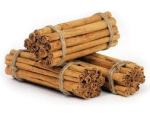
CINNAMON Cinnamon has been used for centuries in its native tropical Asia, with ancient Egyptians using it as a medicament and for flavoring drinks. True cinnamon is made from the inner bark of a young tropical evergreen tree.
Stick: Add to hot, clear beverages (ground cinnamon imparts a cloudy look)
Cook 1 or 2 in a beef or lamb stew along with prunes, apricots and red wine.
Heat pancake syrup with a stick or two.
Ground: Sprinkle over hot chocolate or cappuccino.
Stir into pancake batter or chocolate frosting.
Fold into vanilla ice cream and serve on warm apple pie.
 CLOVES Cloves are the strongest of all the aromatic spices, and have been used as a seasoning since time immemorial. The first records date from China, in the third century BC, when they were used by the Chinese both to cure toothaches and to sweeten the breath.
CLOVES Cloves are the strongest of all the aromatic spices, and have been used as a seasoning since time immemorial. The first records date from China, in the third century BC, when they were used by the Chinese both to cure toothaches and to sweeten the breath.Whole: Drop 1 in a cup of tea or add a few to the pot when making mulled cider or wine.
Use to fasten canned pineapple or apricots on ham before baking to impart a delightful flavor.
Cook a few in chili con carne.
Ground: Add a pinch to chocolate cake batter or frosting.
Add a dash to baked beans.
Stir a pinch into honey; spoon over sliced oranges.
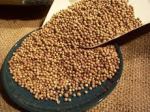
CORIANDER Seeds of the cilantro (Chinese parsley) plant are called coriander. Coriander also has a long history and was mentioned in the Old Testament; it was used in ancient Rome both as a condiment and a medicament. Coriander has a pleasant scent and a spicy, sweetish taste akin to lemony sage with a sweet touch.
Seeds: Add to pickles and marinades.
Add to vinegar dressings.
Ground: Use to flavor poundcake.
Use in place of cinnamon to flavor apple pie.
Add to frying batters.
Toss melon chunks with coriander and sugar.

CUMIN Ground cumin is an essential in curry and chili powders with a pungent aroma and a sharp taste. This spice, which is an annual plant belonging to the carrot family, was well known in ancient Egypt, having been found in the Great Pyramids.
 Seeds: Stir into cheese spreads.
Seeds: Stir into cheese spreads.Add a few to the cooking water for rice or couscous.
Ground: Freshen up canned or homemade chili or lentil soup.
Add a pinch to bottled salad dressing.
Stir into yogurt with chopped cucumber and serve with spicy curries.
For a cooling summer drink, season yogurt with cumin and salt and then thin with cold water to taste.

FENNEL The fennel plant resembles the dill plant, and likewise it is the seeds that are used for flavoring dishes. The seeds are green or greenish-yellow to brownish with a strong scent and a pleasant, slightly sweet taste.
Seeds: Turn sage sausage into a sweet Italian-work in fennel seeds and refrigerate overnight before cooking to blend flavors.
Add fennel seeds, peppercorns and thyme to a marinade for olives and carrot slices.
Add to a hearty fish soup.
Stir into bread dough and sprinkle on top of loaves before baking.
Ground: Sprinkle lightly over sausage pizza.
Mix into bread crumbs to coat fish before pan-frying.
Add to eggs or fish sauces.
Stir into coffeecake batters.

GINGER Ginger is a tropical perennial plant that is cultivated for its tuber-like thickened rhizomes. It has a long history and was well known for its medicinal properties by the Romans and Greeks, and has also been mentioned in old Chinese manuscripts. Freshly grated ginger is very pungent, with the dried powder slightly less so. Ginger is added to various spice mixtures and is also used to flavor beverages such as ginger-ale and ginger-beer.
Ground: Sprinkle salmon fillets with lime juice and ginger before baking.
Sprinkle slices of refrigerated cookie dough with ginger and sugar before baking.
Stir into lemonade or iced tea.
Mix into fresh fruit salads.
Sprinkle with sugar, on grapefruit halves before broiling.
Stir into mashed sweet potatoes.
Add to sweetened whipped cream.
Use in preparing custards.


MUSTARD Yellow is the most common, but the seeds grow brown and black, too. Each has a slightly different flavor, from mellow to pungent, with all three combined to make the ‘mustard powder’.
Seeds: Add to pickling brine.
Add to simmering brisket or corned beef.
Dry-roast the seeds in a skillet until they pop. Then add to braised cabbage or hot green beans.
Powder: Mix to a paste with cold liquid before adding to other food, to prevent clumping.
Add, with roasted seeds, to white sauce. Serve it with fish and meats.
To make hot Chinese mustard, mix it with water. Let it stand for 10 minutes.

NUTMEG & MACE Mace is the covering of the nutmeg seed, and the two can be used interchangeably. Freshly grated nutmeg (use a nutmeg grater or the fine holes of a standard metal grater) gives a more intense flavor.
 Stir a pinch into cream sauces and soups.
Stir a pinch into cream sauces and soups.Great with winter squash, mashed sweet potatoes, glazed carrots or parsnips.
Flavor apple or pear pie (in place of cinnamon).
PAPRIKA Made from dried sweet red peppers, paprika adds warm color and flavor to your dishes. The finest paprika is from Hungary. Paprika comes in hot, mild or sweet, which really is not hot at all.

Ground: Stir, with minced onion, into cream cheese for a delightful sandwich spread.
Add to fat before frying potatoes.
Sprinkle as a garnish on otherwise colorless foods.
Rub on poultry before roasting or baking.
 PEPPER Is there any food that does not benefit from a good grinding of fresh peppercorns? Black pepper is the most common, but to spice up your daily grind add a few pink or green peppercorns to your mill.
PEPPER Is there any food that does not benefit from a good grinding of fresh peppercorns? Black pepper is the most common, but to spice up your daily grind add a few pink or green peppercorns to your mill. Cracked or coarsely ground: Coat steaks or chicken breasts before grilling.
Freshly ground: Add to spice cookie dough or gingerbread.
Sprinkle strawberries lightly with pepper and balsamic vinegar for a summer dessert.
Grind over ripe melon and grapefruit halves.
Grind some white pepper into lemonade.


No comments:
Post a Comment